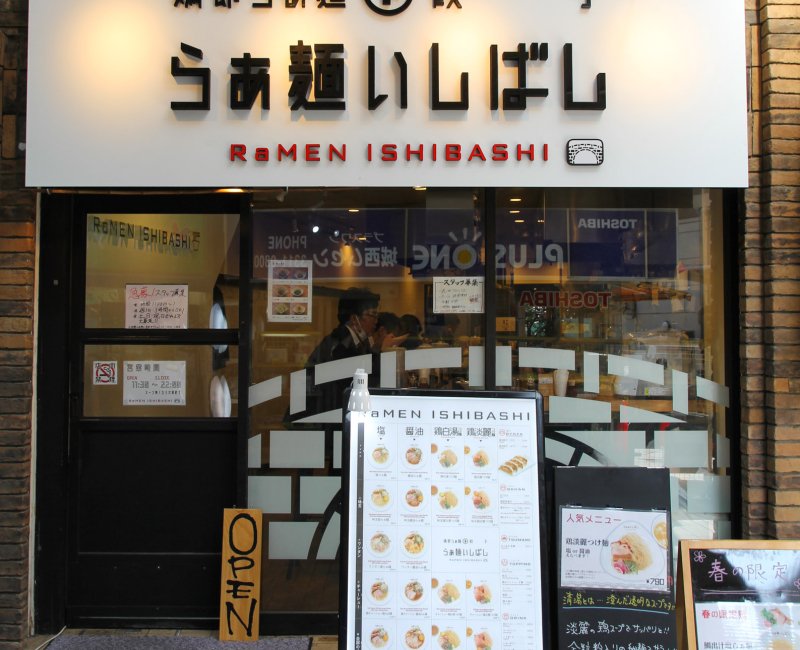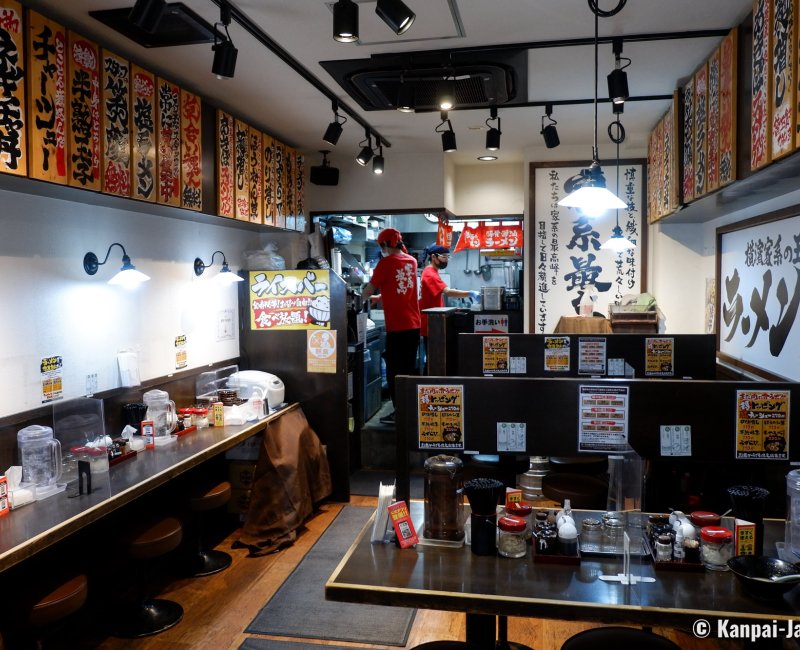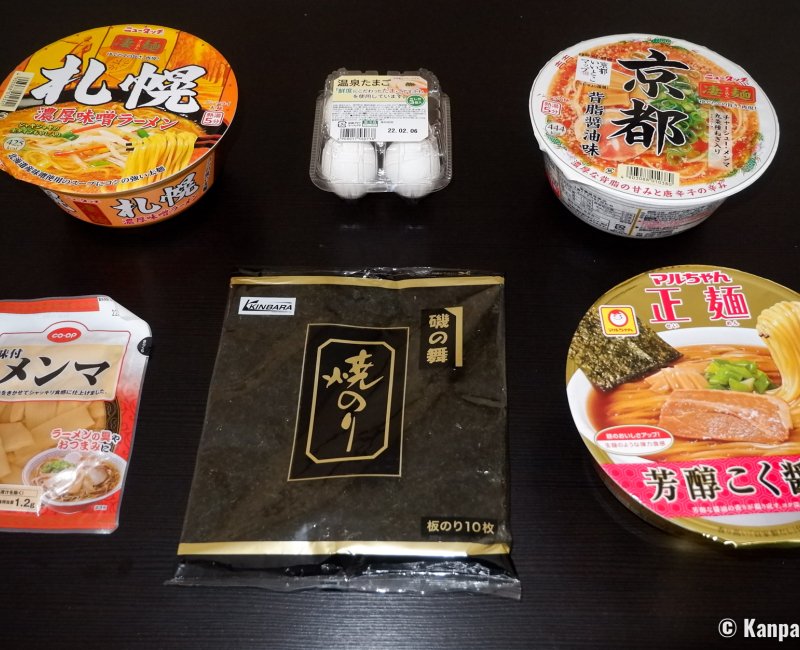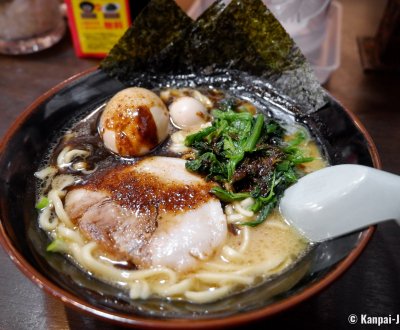Ramen
🍜 Japan’s Beloved Noodle Soup
Japanese ramen consists of a bowl of noodles soaked in a hot broth and topped with vegetables, eggs, meat and fish. This popular dish originating from China is hearty, affordable and quick, and enjoyed as a daily staple. There is an infinity of ways to serve ramen, and everyone can enjoy the many variations of its savory broth.
A living culinary art in Japan, ramen 🍜 is such a popular dish that it can make crowds move. As a matter of fact, any restaurant receiving good ratings on a magazine, on television or on the social networks is sure to see the appearance of a long queue of amateurs, ready to wait to try the newest trendy ramen dish.
A ramen meal consists of a broth poured in a bowl, into which noodles, toppings and sometimes additional seasoning are added. Ramen is often sided with a plate of gyoza 🥟 dumplings or rice for the big eaters, and served with a glass of light beer 🍺.
Ramen is a dish quick to serve and to eat, however, its cooking is long and complex for the broth requires a long simmering to fully develop all its flavors. That is the reason why most of Japanese people eat their noodles out at one of the many specialized ラーメン屋 ramen-ya joints.
Ramen are delicious but also a good solution for a healthy and affordable food in Japan: allow about ¥500 (~US$3.21) to ¥1,000 (~US$6.42) on average for a noodle bowl at the restaurant.

Introduction of Chinese noodles in Japan
The dish was initially introduced from China, with the noodles called lamian. It was supposedly introduced for the first time in Japan during the Edo period (1603 – 1868), but various sources have found it could have been earlier. Its popular success grew between the end of the 19th century and the early 20th century.
A recent diffusion
It is generally acknowledged that the rise of ramen in Japan began with the arrival of long-term Chinese immigrants in the archipelago during the Meiji Era (1868 – 1912). They first settled in important port towns of the country such as Yokohama or Kobe, and soon lived in dedicated Chinese districts, therefore opening many typical shops, including restaurants serving a dish based on rice noodles dipped in a salted broth.
Over time, some staple ingredients of Japanese cuisine, such as soy sauce and dashi broth, were used to better blend the dish into the national gastronomy. According to the legend, the first renowned Japanese ramen restaurant was established in Asakusa, in Tokyo.
Post-war boom
The end of WWII is a milestone in the history of Japanese ramen. Due to a lacking rice production, noodles were made from wheat flour. The yatai food stalls that usually served this hot and cheap dish were officially forbidden due to a very strict food rationing. The yakuza mafia groups took upon themselves to protect this market and arranged for the soup noodles to still be served, even at the black market.
Later, the stalls became renowned restaurants, specialized in this delicious dish always affordable for the majority of the population.
The invention of instant ramen
At the end of the 1950s, Momofuku Ando (1907 – 2007) the famous Taiwanese-Japanese founder of Nissin, invited the instant noodles. This simple and extremely convenient idea is also very affordable. He used a plastic cup to combine:
- Dried noodles;
- Powdered broth; and,
- Dried toppings such as small bites of dehydrated seaweed.
You just have to pour hot water in the cup to heat all the ingredients and thus get a bowl of steaming hot noodles in a couple of minutes.
In 1971, Nissin launched the famous Cup Noodles brand in Japan, and several other companies started to develop the same kind of instant ramen, that is now widespread in all supermarkets and konbini in the country. The individual portions costs on average between ¥100 (~US$0.64) and ¥150 (~US$0.96).
Fun fact, 2 museums dedicated to Momofuku Ando are worth the detour for instant noodles amateurs, in Yokohama and Ikeda City (in the north-west of Osaka).
4 classical broth recipes
Men noodles are always made from wheat and kansui, a food additive (potassium carbonate) often used in the preparation of Asian noodles. They may vary in thickness although they usually are thin and wavy. The most common toppings are:
- Chashu: thin cooked pork slices;
- Menma bamboo shoots;
- Ajitsuke tamago: a soft-boiled marinated (chicken or quail) egg;
- Dried nori seaweed;
- A slice of narutomaki 🍥 or kamaboko white fish;
- Various vegetables such as spinach, mushrooms, minced onions or corn, and sometimes,
- Additional spices such as pepper, sesame or chili pepper.
The broth is the most important ingredient as its gives the dish its main flavor. Its cooking is the part allowing the most variations and possibilities. Therefore, there are 4 main ramen categories, set according to the ingredients used in the broth recipe.
Salt-flavored Shio Ramen
The broth in Shio Ramen (塩ラーメン) is characteristically salty, with a clear yellow color and a light taste. Considered as one of the oldest Japanese ramen types, it makes a good association with chicken and vegetables toppings.
Soy sauce Shoyu Ramen
Shoyu Ramen (醤油ラーメン), as states the name, has a broth based on soy sauce; its color is of a slightly more darker brown. The recipe goes well with pork or beef and is widespread in Japan, especially in the Kanto area and in the capital.
Miso soybean paste Ramen
Originating from Hokkaido in the north of Japan, the Miso Ramen (味噌ラーメン) broth is enriched with fermented soybean paste, giving it a thicker texture. Its coloration varies from beige to brown, and even orange depending on the amount of miso and its type, for example white or red.
With a broth as thick as a soup, Miso Ramen’s taste and perfume are stronger than the 2 previous recipes’. It is often served with corn, garlic, cabbage and sesame seeds. The noodles in Miso Ramen are also hearthier.
Tonkotsu pork bones Ramen
For the Tonkotsu Ramen (豚骨ラーメン), the broth uses pork bones that have been marinated for a long time and obviously looks creamier and thicker. Originating from Fukuoka (Hakata), on Kyushu island, this ramen is certainly the fattest of the classical recipes. With minced garlic, onions, and sometimes pork fat added as topping it is a very hearty dish.
Infinite Variations
Actually, each chef brew their own broth, building on a long experience and a recipe that is often kept secret. The possible variants are countless and there are also new original ramen such as the delicious tomato ones or the Thai style ramen with a curry sauce base.
Other interesting variations of the noodles meal exist:
- 坦々麺 tantan-men originating from Chinese cuisine and served in a sesame-based spicy broth;
- As well as 油そば abura soba or まぜそば maze soba where the broth is replaced by a slight dose of oil.
Ramen styles also vary according to regions in Japan, and their characteristics are profusely promoted, such as:
- In Tokushima, the tonkotsu broth is associated to shoyu for a unique blend;
- In Kagoshima, the tonkotsu broth is prepared with local black pork bones and chicken; and,
- In Nagasaki, the favorite recipe is of Chinese inspiration, with the noddles cooked directly in the broth.
The Japanese often choose their vacation destination according to the local specialties available to taste, consequently regional ramen are a touristic asset.

Eating at a ramen restaurant
The tips to finding good restaurants are the same as for udon or soba noodles restaurants. The popularity of the place can be evaluated thanks to the length of the waiting line, as well as thanks to the reviews found on the internet 📶. It is also possible to ask a local resident for their best addresses.
Restaurant chains
Many Japanese fast food chains are specialized in ramen bowls and spread throughout the archipelago. They thrive thanks to a popular and characteristic broth recipe, or thanks an original menu of ingredients and seasoning to choose from to customize the dish. For example, you can find the following chains:
- 麺屋武蔵 Menya Musashi;
- 壱角家 Ichikakuya;
- 龍の家 Tatsunoya;
- 一蘭 Ichiran Ramen specialized in the tonkotsu broth;
- タイガー餃子 Tiger Gyoza, a Chinese chain also serving delicious sesame ramen; and,
- 東京油そば Tokyo Abura Soba whose shops in Koenji and Ginza are particularly recommended.
Good ramen joints in Tokyo
We also have a short list of independent restaurants in Tokyo that we already tried and highly recommend:
- 味噌が一番 Miso-ga-Ichiban in Nakano;
- 麺屋ぬかじ Menya Nukaji in Shibuya;
- 麺屋はやしまる Menya Hayashimaru in Koenji; and,
- きび太郎 Kibitaro in Asakusa.
This list is naturally too short as there as countless good ramen restaurants in Tokyo and in Japan generally speaking. Joints catering for people on a vegetarian or vegan diet, have increasingly developed in the capital in the past few years, with shops guaranteed 100 % without animal products, or serving specific courses, such as the chains:
- 九州じゃんがら Kyushu Jangara;
- ソラノイロ Soranoiro; and,
- T's たんたん T’s-Tantan, certainly the most renowned, with restaurants in train stations and airports.
Ordering at the vending machine
Most of ramen restaurants have a vending machine at their entrance, to which customers order and pay upon arrival. The terminal delivers a ticket that is to be handed to the staff working behind the kitchen counter. Then customers can seat at a table and wait to be served.
Sometimes, wax sample meals or pictures are displayed to boost appetite or help non-Japanese speakers in the order process. Cash is the main payment method.
How to enjoy a bowl of ramen
People who are used to it won’t be surprised, but ramen are better enjoyed when making loud "slurping" noises. This unusual way of eating allows to cool down the noodles that have been soaking in a steaming hot broth and it is also a way of showing you are enjoying the food.
As for quantities, they are generally rather large and a standard noodle bowl is quite filling. Depending on the restaurant, it is possible to twist your ramen with variations on:
- The cooking of the noodles (firm or soft);
- The concentration of the broth (clear or thick); and,
- The spices (garlic or chili sauce for example).
Ramen is a popular meal and the waiting line can be long depending on the chosen hour and restaurant, so eating as soon as being served and leave quickly upon finishing is good practice in Japan. If you want to take your time to chat, drink or have a dessert, you may want to continue to another shop, such as a cafe or a tearoom.


